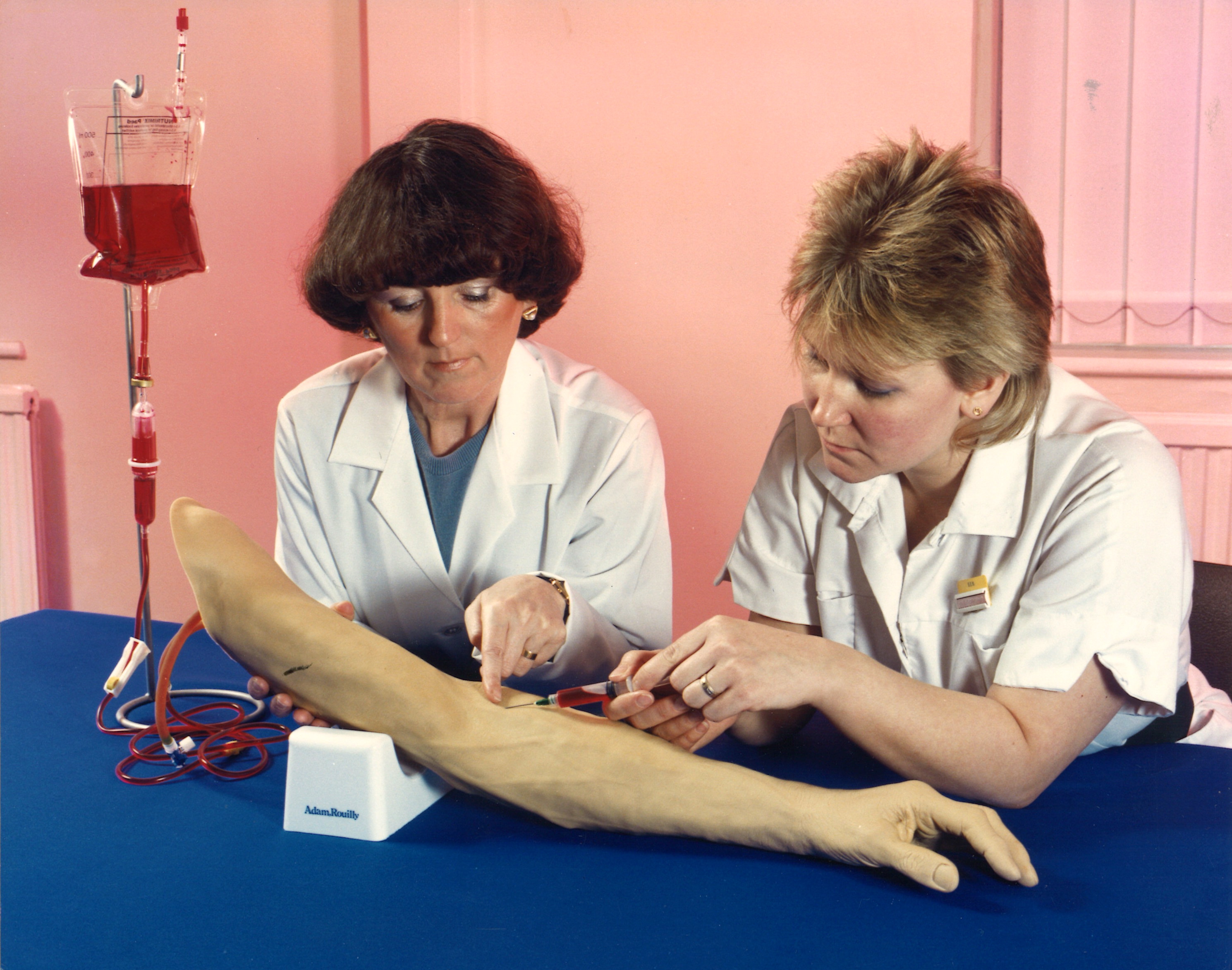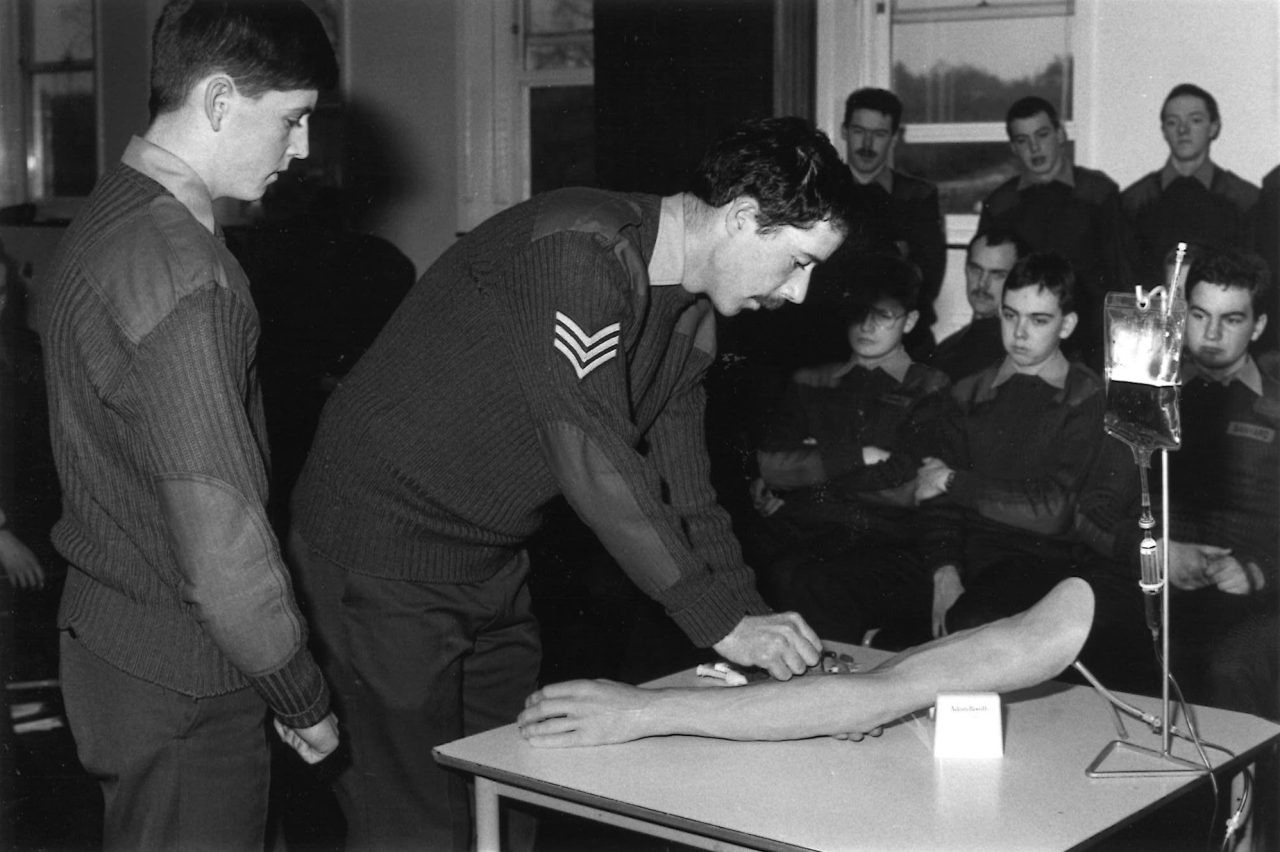
In addition to selling medical simulators on behalf of carefully-selected and trusted suppliers, we also design and manufacture a wide range of items at our purpose-built, UK-based facility in Kent.
One of the most popular Adam,Rouilly products is the AR251(-B) Injection, Venepuncture, Cannulation & Infusion Arm, which is used in a variety of clinical skills teaching settings. Adam,Rouilly injection arms are distributed worldwide each year.
Still one of our best-selling task trainers today, it was a request from the British Army more than 40 years ago which first gave birth to the injection arm.
Like many of the items we directly manufacture, this particular product was initially created in partnership with medical professionals, in response to a specific training need.
It was 1983 and traditional class instruction was giving way to the rapid advancement of task-based training using models and simulators. It was no longer acceptable to use patients and students for practice and the focus shifted to making the step from model to human as narrow as possible.
The problem faced by the Army was finding an arm that was both realistic and robust enough to withstand the rigorous and multiple uses required to give large groups of soldiers basic first aid and intravenous cannulation training.
As we were already familiar with producing anatomical models for nursing and obstetrics, designing these new task-specific training models was a natural progression for Adam,Rouilly.
Arm models for IV injections, infusions and cannulation

Our injection arms are cast from life, and it was our then factory manager, Bob Morley, who kindly volunteered as the first model. Bob had a very well-developed forearm thanks to his love of fencing.
It was an unfortunate oversight that Bob hadn’t shaved his arm first, but the resulting mould was incredibly realistic, if not somewhat painful to remove!
The first arms were moulded in PVC, a durable and washable plastic, but it has been improved and enhanced over the years.
The skin is now moulded from a specially-selected grade of silicone for improved feel, durability and palpation of the veins. The veins themselves are more pronounced in the antecubital fossa region of the forearm and on the back of the hand, while the wrist is flexible for added realism. These features, together with accessible dorsal metacarpal, cephalic, median cubital and basilic veins, result in an incredibly realistic sensation when the skin and vein are penetrated.
The closed blood system is clean to use and demonstrates a realistic ‘flashback’ to confirm correct needle placement in the vein before blood is withdrawn.
Overall, the arm has been designed as an incredibly realistic and durable model for the training of IV injections and infusions, intravenous cannulation on the back of the hand or forearm, setting up and monitoring infusions, and withdrawal of blood using a syringe or vacutainer.
As with all Adam,Rouilly manufactured items, every stage of the production process is managed by skilled technicians on site.
All the components, including the core, skin, latex veins, end cap, pressurised bottle system with valves and powdered blood, are assembled individually by hand to create the finished arm.
Built to last – servicing injection arms
Because the injection arm model is used to teach such a core medical skill, it needs to be robust enough to withstand repeated use.
The Adam,Rouilly arm has several features which are carefully-designed to make it last as long as possible:
- The clean closed blood system which keeps liquids contained and greatly reduces the risk of leaks
- Durable silicone skin which allows many procedures to be carried out before it needs replacing
- Self-sealing veins which can withstand many needle insertions
- Replacement skins and veins which customers can easily fit themselves
- Adam,Rouilly servicing and repairs facility
Production Manager, Clive Baker, has been part of the Adam,Rouilly family for 36 years, and has overseen the production of thousands of injection arms in that time.
“These arms are built to last. And because they are serviceable, they can go on for many years,” Clive explained. “We’ve had arms coming back that have lasted 30 to 40 years. I even saw an old Adam,Rouilly injection arm on one of these antiques TV programmes – I almost spat my tea out!
“Customers can easily replace the skin and veins themselves, or send the arms back to us for a full service, including re-skinning, re-veining, a thorough check and a deep clean.”
We also offer a range of arms from other suppliers, for teaching procedures such as IV Therapy and Phlebotomy, Arterial Puncture/Blood Gas, Paediatric Injection, Haemodialysis, IV Demonstration, Suture Practice and Blood Pressure checking.
For more information about Injection Arms, or any other Clinical Skills simulators and anatomical models, please contact our Sales team.